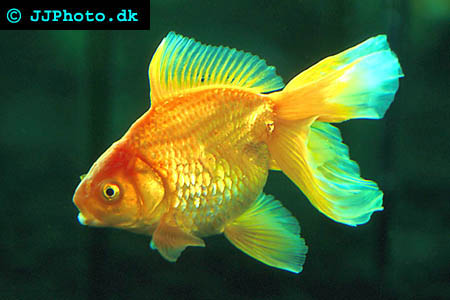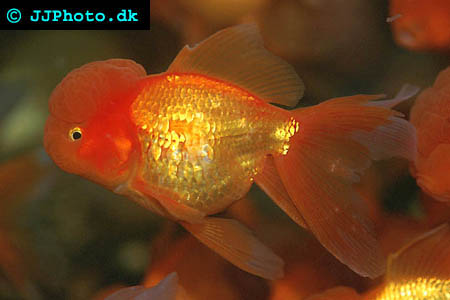Breeding Goldfish
Goldfish cover a wide range of species, but they are all members of the generic family Carassius auratus, and have been bred by the Chinese, Koreans and Japanese. One of the difficulties for the amateur to breed this fish is that they can be difficult to sex. The difference in their gender is only apparent when they are in a spawning condition. The greatest change occurs in the males, they develop white pimples known as "breeding tubercles", on their fins and sometimes their head. Check along the gill operculum, and along the front rays of their pectoral fin.
Goldfish are capable of breeding when they are a year old, but they are in their prime during their third year. Under normal circumstances, it is impossible to tell their sex until they have grown to 8cm. Therefore it is impossible to buy a small fish and be certain of its gender. Many breeders advocate that the sexes should be kept apart before the breeding commences, and this is impossible before they are sexed. Therefore breeding of goldfish can be a long term project, as they first have to be sexed. This is best done in the Summer, and the fish can be over wintered for breeding in the Spring.
The process of breeding is induced by a change in the temperature of the water. Goldfish will breed at a temperature of 10-26ºC, but the optimum temperature to ensure success is 20ºC. To induce the fish to spawn you can either wait for more clement weather, or you can artificially and slowly raise the temperature of the water. To ensure a greater chance of fertility more males are kept then females, usually the ratio is two to one. Bear in mind here that each fish needs fifteen gallons of water, and they do not like to be overcrowded.
It is easy to spot when they are ready to breed, as the male has a ritual of a “spawning chase”, whereby he follows the female around and pushes against her abdomen, for several hours. This should occur if all the conditions are correct with a few days of the fish being brought together. The female, when she is ready will lay her eggs in batches, the first batch being the most fertile. She can lay from five hundred to a thousand eggs, so they will not be released all at once. The male will immediately fertilize these eggs by spraying milt on to them.
Once the egg laying is over the eggs should be removed from the breeding tank, and rinsed in aged water, which is at the same temperature as the water they have been released from. They should then be placed in a separate twenty gallon tank. However the depth of the water should not exceed six inches, as the pressure of the water inhibits their ability to rise to the surface.
The eggs will hatch at the temperature of 21ºC, so if the water is cooler raise it gently to that temperature. At this stage the clearer looking of the eggs are the most fertile, and therefore have the greater chance of hatching. The darker eggs are infertile, and have a high chance of developing a fungal infection; they should be removed from the tank. A few drops of methylene blue can reduce the chance of fungal activity.

Goldfish breeding have resulted in many types of goldfish over the years
Like this Veiltail Goldfish . Copyright www.jjphoto.dk
Once the fry have been hatched they have a full yolk sac, and they should not beefed during the first forty eight hours. During this time it is normal that they will sink to the bottom of the tank, and they should be left undisturbed. During this period they are absorbing the yolk sac and developing an air bladder. Once the air bladder has developed, they will rise from the bottom naturally.
After forty eight hours they are hungry and ready to be fed. They may be fed from a commercial product or from a paste of oatmeal, and also hard boiled eggs. They need only sufficient food, which they can eat during a twenty minute period, after this time any uneaten food should be carefully siphoned off.

Lionhead Goldfish is another result of selective goldfish breeding.
Others include Oranda Goldfish, Black moor Goldfish and Ranchu Goldfish. Copyright www.jjphoto.dk
Breeding Bristlenosed Catfish - A short introduction to breeding Bristlenosed catfish
Breeding Discus - An introduction to breeding Discus.
Breeding Mbuna Cichlids - An introduction to breeding Mbuna Cichlids
Breeding Oscar Fish - Introduction on how to breed Oscar fish.
Breeding Tiger Barbs - An introduction to breeding tigerbarbs.
Breeding/Rearing Aquarium Tanks - How to setup a good aquarium to raise fry in.
Choosing the parents - An introduction to choosing the right fish for breeding.
Condition the parents - An introduction about how to condition fish for breeding.
Equipment and breeding fish - An introduction to equipment and how to manage a breeding tank.
Failed breedings - An article about failed breedings and how one can prevent the same thing from happening again.
Feeding Fry - An article about how to feed your fry.
Fish Spawning Methods - A introduction to the different spawning methods that are used by fish.
Koi Breeding - An introduction to breeding Koi fish.
Raising fry - An article about how to raise fry.
Spawning Methods - An introduction to the different spawning methods that fish use.
Tips for effective breeding - A few tips on how to successfully breed and raise fish.
Goldfish are capable of breeding when they are a year old, but they are in their prime during their third year. Under normal circumstances, it is impossible to tell their sex until they have grown to 8cm. Therefore it is impossible to buy a small fish and be certain of its gender. Many breeders advocate that the sexes should be kept apart before the breeding commences, and this is impossible before they are sexed. Therefore breeding of goldfish can be a long term project, as they first have to be sexed. This is best done in the Summer, and the fish can be over wintered for breeding in the Spring.
The process of breeding is induced by a change in the temperature of the water. Goldfish will breed at a temperature of 10-26ºC, but the optimum temperature to ensure success is 20ºC. To induce the fish to spawn you can either wait for more clement weather, or you can artificially and slowly raise the temperature of the water. To ensure a greater chance of fertility more males are kept then females, usually the ratio is two to one. Bear in mind here that each fish needs fifteen gallons of water, and they do not like to be overcrowded.
It is easy to spot when they are ready to breed, as the male has a ritual of a “spawning chase”, whereby he follows the female around and pushes against her abdomen, for several hours. This should occur if all the conditions are correct with a few days of the fish being brought together. The female, when she is ready will lay her eggs in batches, the first batch being the most fertile. She can lay from five hundred to a thousand eggs, so they will not be released all at once. The male will immediately fertilize these eggs by spraying milt on to them.
Once the egg laying is over the eggs should be removed from the breeding tank, and rinsed in aged water, which is at the same temperature as the water they have been released from. They should then be placed in a separate twenty gallon tank. However the depth of the water should not exceed six inches, as the pressure of the water inhibits their ability to rise to the surface.
The eggs will hatch at the temperature of 21ºC, so if the water is cooler raise it gently to that temperature. At this stage the clearer looking of the eggs are the most fertile, and therefore have the greater chance of hatching. The darker eggs are infertile, and have a high chance of developing a fungal infection; they should be removed from the tank. A few drops of methylene blue can reduce the chance of fungal activity.

Goldfish breeding have resulted in many types of goldfish over the years
Like this Veiltail Goldfish . Copyright www.jjphoto.dk
Once the fry have been hatched they have a full yolk sac, and they should not beefed during the first forty eight hours. During this time it is normal that they will sink to the bottom of the tank, and they should be left undisturbed. During this period they are absorbing the yolk sac and developing an air bladder. Once the air bladder has developed, they will rise from the bottom naturally.
After forty eight hours they are hungry and ready to be fed. They may be fed from a commercial product or from a paste of oatmeal, and also hard boiled eggs. They need only sufficient food, which they can eat during a twenty minute period, after this time any uneaten food should be carefully siphoned off.

Lionhead Goldfish is another result of selective goldfish breeding.
Others include Oranda Goldfish, Black moor Goldfish and Ranchu Goldfish. Copyright www.jjphoto.dk
Didn't find the info you were looking for? Register for free and ask your question in our Aquarium forum !
Our knowledgeable staff usually responds to any question within 24 hours
Related Articles
Breeding Angelfish - Information about Breeding AngelfishBreeding Bristlenosed Catfish - A short introduction to breeding Bristlenosed catfish
Breeding Discus - An introduction to breeding Discus.
Breeding Mbuna Cichlids - An introduction to breeding Mbuna Cichlids
Breeding Oscar Fish - Introduction on how to breed Oscar fish.
Breeding Tiger Barbs - An introduction to breeding tigerbarbs.
Breeding/Rearing Aquarium Tanks - How to setup a good aquarium to raise fry in.
Choosing the parents - An introduction to choosing the right fish for breeding.
Condition the parents - An introduction about how to condition fish for breeding.
Equipment and breeding fish - An introduction to equipment and how to manage a breeding tank.
Failed breedings - An article about failed breedings and how one can prevent the same thing from happening again.
Feeding Fry - An article about how to feed your fry.
Fish Spawning Methods - A introduction to the different spawning methods that are used by fish.
Koi Breeding - An introduction to breeding Koi fish.
Raising fry - An article about how to raise fry.
Spawning Methods - An introduction to the different spawning methods that fish use.
Tips for effective breeding - A few tips on how to successfully breed and raise fish.
